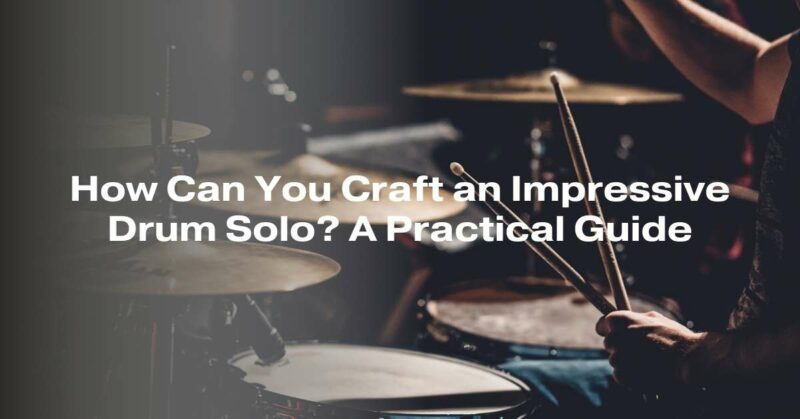Drum solos are the heartbeat of a music performance, a moment when the drummer takes center stage to showcase their skill, creativity, and musicality. Crafting an impressive drum solo is a task that requires more than just technical proficiency; it demands a deep understanding of rhythm, dynamics, and the ability to connect with the audience on an emotional level. In this practical guide, we will explore the essential elements and strategies to help you craft a memorable and impressive drum solo.
1. Master the Fundamentals
Before embarking on a drum solo journey, it’s crucial to have a solid foundation in drumming. This includes proficiency in basic drumming techniques, such as hand and foot coordination, rudiments, and a good understanding of rhythm. Without these fundamental skills, it will be challenging to create a captivating solo.
2. Know Your Gear
Familiarity with your drum kit is paramount. Experiment with different drum sizes, cymbals, and other percussion instruments to discover the unique tones and textures they offer. Make sure your kit is well-maintained and tuned properly to ensure you get the best sound quality.
3. Study Influential Drummers
Great drummers often draw inspiration from those who came before them. Take time to study the techniques and styles of influential drummers across various genres. Whether it’s the jazz brilliance of Buddy Rich, the rock groove of John Bonham, or the complexity of Neil Peart, learning from these masters can enrich your drumming vocabulary.
4. Develop a Strong Sense of Timing
A solid sense of timing is non-negotiable for any drummer. Use metronomes and drum machines to practice keeping a consistent tempo. Understanding different time signatures and subdivisions will also give you the flexibility to experiment with rhythm in your solos.
5. Build Dynamic Range
An impressive drum solo isn’t just about speed and complexity; it’s also about dynamics. Practice playing at various volume levels, from soft and subtle to loud and thunderous. Experiment with crescendos, decrescendos, and sudden dynamic shifts to add depth to your performance.
6. Structure Your Solo
Crafting a well-structured drum solo is crucial. Begin with an engaging introduction that grabs the audience’s attention. Then, build tension and excitement through the body of the solo, incorporating variations in rhythm and dynamics. Finally, conclude with a memorable and powerful climax.
7. Tell a Musical Story
A drum solo should tell a story, just like any other musical composition. Think of it as a journey with a beginning, middle, and end. Use different rhythmic patterns, fills, and accents to convey different emotions and moods throughout your solo.
8. Incorporate Melodic Elements
While drums are primarily percussive instruments, there are ways to introduce melodic elements into your solo. Utilize pitched percussion instruments like timpani, xylophone, or even tuned drums to create melodic motifs that complement the overall composition.
9. Practice Improvisation
Improvisation is a key aspect of crafting an impressive drum solo. Practice improvising over various musical styles and backing tracks to develop your ability to think on your feet. This will allow you to adapt to different performance situations and connect with the audience in real-time.
10. Engage with Your Audience
Remember that a drum solo is not just a display of technical prowess but also a means of connecting with your audience. Maintain eye contact, smile, and use body language to convey your passion for drumming. A solo that engages the audience emotionally will be far more memorable than one that focuses solely on technicality.
11. Record and Analyze Your Performances
Recording your drum solos and listening to them critically is an excellent way to identify areas for improvement. Take note of what worked well and what could be enhanced. This self-assessment will help you refine your skills over time.
12. Seek Feedback
Don’t hesitate to seek feedback from fellow musicians, teachers, or mentors. They can provide valuable insights and suggestions for improving your drum solos. Constructive criticism is an essential part of growth as a musician.
13. Perform Regularly
Practice makes perfect, but performing in front of an audience is where your skills truly come to life. Whether it’s playing at local gigs, open mics, or jam sessions, regular live performances will help you build confidence and refine your stage presence.
14. Stay Inspired and Creative
Keep your passion for drumming alive by staying inspired and open to new ideas. Experiment with different genres, collaborate with other musicians, and push the boundaries of your creativity. The most impressive drum solos often come from musicians who are willing to take risks and think outside the box.
In conclusion, crafting an impressive drum solo is a rewarding journey that requires dedication, creativity, and a deep understanding of rhythm and dynamics. By mastering the fundamentals, studying influential drummers, and connecting with your audience on an emotional level, you can create drum solos that leave a lasting impact and showcase your unique musical voice. So, pick up your sticks, hit the drums, and let your creativity flow to craft the drum solo of a lifetime.


